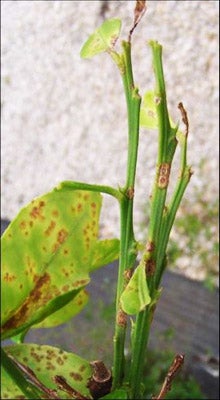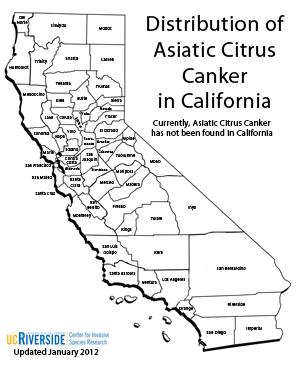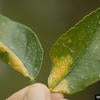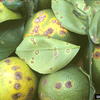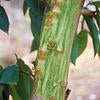The Asiatic Citrus Canker, Xanthomonas axonopodis pv. citri
The Situation: Asiatic citrus canker is a widespread bacterial disease in Asia and in certain other citrus-growing regions of the world. It was eradicated from the U.S. after its introduction in the early part of this century. New infestations of true Asiatic citrus canker have been recently detected in Florida, suggesting that the introduction of this serious pathogen is a continuing threat.
Damage: Strains of Xanthomonas axonopodis pv. citri vary in aggressiveness, but typically cause raised, corky lesions on fruit, stems, and leaves. Under
conditions favorable to the pathogen, severe branch die back and even death of trees can occur. In most cases, younger leaves are considered to be most susceptible to infection, and damage caused by citrus leaf miner larvae (Phyllocnistis citrella) can be sites for infection to occur. Within a controlled laboratory setting, symptoms can appear in 14 days following inoculation into a susceptible host. In the field environment, the time for symptoms to appear and be clearly discernible may be on the order of several months after infection. Lower temperature increases the latency of the disease. Citrus canker bacteria can stay viable in old lesions and other plant surfaces for several months. The drier conditions of California are generally considered to be less conducive to the establishment and spread of bacterial diseases such as citrus canker, which depend on wind-driven rain and high humidity for initial infection. However, UC Riverside researchers recently discovered an avocado branch and trunk canker disease caused by another pathovar of Xanthomonas that is widespread in coastal counties of California. This demonstrates that bacterial diseases of this type can persist in our climate on subtropical tree crops.
Economic Impact:Between 1915 and 1933, more than $6 million was spent in Florida alone on the first eradication effort for citrus canker in the southeastern U.S. In the more recent eradication effort in the 1980s, over 20 million trees were burned in Florida at a cost of nearly $94 million. In addition to potential loss of citrus quality and productivity from the disease, the strongest economic impact is from regulatory restrictions on the shipment of fruit from regions found to be infested with citrus canker and from costly efforts to eradicate the disease when it is introduced.
Distribution: Asiatic citrus canker is widespread in several citrus-producing countries (e.g., south east Asia, Australia, USA, and Brazil) but has yet to reach California. The bacteria may be introduced to new areas through infected propagative materials used in citrus production and through movement of infected fruit and leaves by the public. The bacterium is spread locally by wind-driven rain, which is the condition usually required for infection to occur. In Florida, over 16 million trees have been destroyed in an attempt to eradicate the disease after the current outbreak started in 1995. It is now in 24 counties resulting in the entire state being placed under a USDA quarantine which prohibits shipment of citrus from Florida to any citrus-producing states. The 2004-05 hurricanes spread the disease so far that in 2006, the USDA determined that eradication is no longer possible and ceased the tree removal program.
Research: Substantial research has been conducted by the University of Florida in recent years to better understand the epidemiology of citrus canker and to differentiate between the aggressive Asiatic citrus canker and other bacteria that cause mild diseases of citrus. Researchers at UC are also assessing the likelihood of establishment in California, and continued monitoring for disease introductions in potentially susceptible coastal citrus areas must continue.
More Media on the Citrus Canker
idTools.org: Citrus Diseases
PlantManagementNetwork.com: Citrus Canker: The Pathogen and Its Impact
Invasive.org: Citrus Canker images
Center for Invasive Species Research, University of California Riverside
Text Provided By: Donald A. Cooksey , updated by Mark S. Hoddle
Photos by University of Florida/ UC Statewide Integrated Pest Management Program and Invasive.org
Donald Cooksey, Divisional Dean, Agricultural & Natural Resources, Professor of Plant Pathology and Bacteriologist
donald.cooksey@ucr.edu
Mark Hoddle, Extension Specialist and Director of Center for Invasive Species Research
mark.hoddle@ucr.edu
Personal Website
